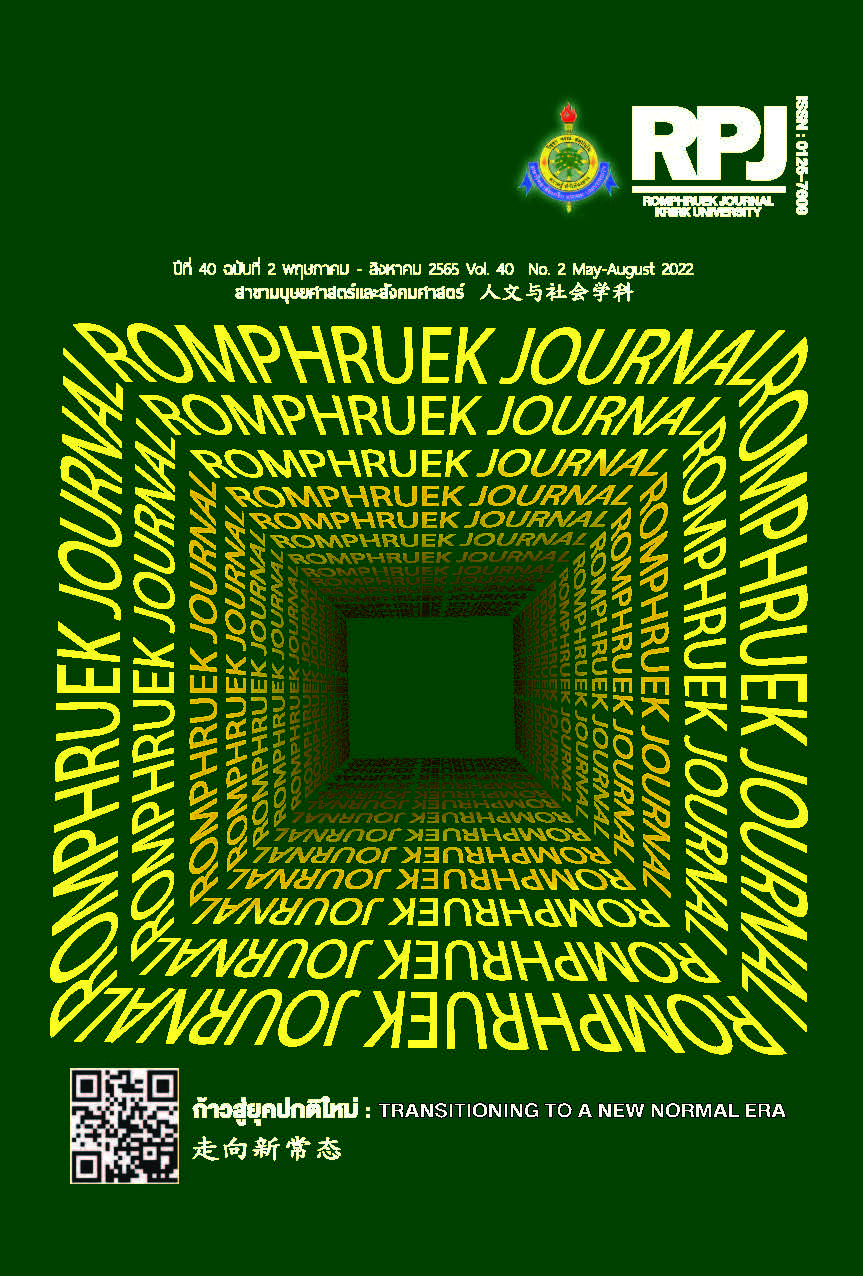Perspective and Expectation of General Public Upon The Conservation and Development of The Bangkok Railway Station (Hua Lamphong)
Main Article Content
Abstract
This research ‘Perspective and Expectation of General Public upon the Conservation and Development of the Bangkok Railway Station (Hua Lamphong)’ aims to 1) study the general public perception upon the value of Bangkok Railway Station (Hua Lamphong), and 2) study the perspective and expectation of general public upon the conservation and development of the Bangkok Railway Station (Hua Lamphong). The research methodology is survey research by using ‘Google Form’ online questionnaires together with VDO clip on platform online. The population of the research are service user group and education sector group. The returned questionnaires are 208 or 90.43%. The research findings are (1) perspective of value for the general public comprises of 6 dimensions : – history, architecture, economy, culture, society and others, and (2) perspective and expectation of future of the station are conservative area, activity area, commercial/creative economy and park respectively.
Article Details

This work is licensed under a Creative Commons Attribution-NonCommercial-NoDerivatives 4.0 International License.
Every article published in the Romphruek Journal of the Humanities and Social Sciences is the opinion and point of view of the authors. Thery're not the viewpoint of Krirk University or the editored department. Any part or all of the articles for pablication must be clearly cited.
References
การรถไฟแห่งประเทศไทย. (ม.ป.ป.). สถานีกรุงเทพ (20 ตุลาคม 2564) สืบค้นจาก https://dlink.me/28q6V.
โครงการวิจัยอนุรักษ์และพัฒนาสถานีรถไฟกรุงเทพ-หัวลำโพง. (2564). แบบสอบถาม “การศึกษาเพื่อวางกรอบในการอนุรักษ์และพัฒนาพื้นที่สถานีรถไฟกรุงเทพ (หัวลำโพง)”. (1 พฤษภาคม 2564) สืบค้นจาก https://www.facebook.com/HualumpongResearchProject.
ธิป ศรีสกุลไชยรัก และคณะ. (2563). รายงานการวิจัยการศึกษาคุณค่าเชิงอัตลักษณ์และความต้องการทางสังคมเบื้องต้นในการอนุรักษ์พัฒนาสถานีรถไฟหัวลำโพง. กรุงเทพฯ : สำนักงานกองทุนสนับสนุนการวิจัย (สกว.).
บ้านและสวน. (2564). เจาะลึกสถานีกรุงเทพ สถาปัตยกรรมหลังคาโค้งกว้างที่สุดเมื่อ 105 ปีก่อน. (7 กุมภาพันธ์ 2565) สืบค้นจาก https://www.baanlaesuan.com/231636/design/design-update/places/bangkok-railway-station.
ปิ่นรัชฎ์ กาญจนัษฐิติ. (2552). การอนุรักษ์มรดกสถาปัตยกรรมและชุมชน. กรุงเทพฯ : โรงพิมพ์แห่งจุฬาลงกรณ์มหาวิทยาลัย.
เฟื่องอรุณ ปรีดีดิลก และคณะ. (2564). การศึกษาเพื่อวางกรอบในการอนุรักษ์และพัฒนาพื้นที่สถานีรถไฟกรุงเทพฯ (หัวลำโพง). หน่วยงานบริหารและจัดการทุนด้านการเพิ่มความสามารถในการแข่งขันของประเทศ (บพข.), กรุงเทพฯ.
มณฑลี ภู่กฤษณา. (2563). อิทธิพลทางสังคมและเศรษฐกิจในการอนุรักษ์และปรับปรุงมรดกในทางสถาปัตยกรรมชุมชนปากน้ำประแส อำเภอแกลง จังหวัดระยอง. บัณฑิตวิทยาลัย มหาวิทยาลัยศิลปากร, กรุงเทพฯ.
วรรณศิลป์ พีรพันธุ์. (2010). กฎบัตรและมาตรฐานระหว่างประเทศที่เกี่ยวข้องกับการอนุรักษ์เมือง. วารสารวิจัยและสาระสถาปัตยกรรม/การผังเมือง, 7(10), 1-10.
วิมลรัตน์ อิสระธรรมนูญ, (2561). ข้อพิจารณาในการปรับใช้แนวคิดการอนุรักษ์มรดกวัฒนธรรมเมืองในระดับสากลกับการอนุรักษ์ในประเทศไทย. วารสารวิชาการสถาปัตยกรรมศาสตร์ จุฬาลงกรณ์มหาวิทยาลัย. 1(67), 65-86.
สกุลศรี ศรีสารคาม. (2560). กระบวนการของสื่อสังคมในการกำหนดวาระข่าวสารเพื่อการขับเคลื่อนประเด็นสังคมสู่การรับรู้และการเปลี่ยนแปลง. วารสารวิจัยราชภัฏพระนคร สาขามนุษยศาสตร์และสังคมศาสตร์, 12(1), 236-249.
Anderson, J. (1992). Living history : Simulating everyday life in living history museums. In P.F. Leffler & J. Brent, Public History Readings. Malabar, FL : Krieger Publishing Company.
Baruch, Y. (1999). Response rates in academic studies—a comparative analysis. Human Relations, 52(4), 421–434.
Evans, J. R. & Mathur, A. (2005). The value of online surveys. Internet Research, 15(2), 195-219. Doi: 10.1108/10662240510590360
Historic Places Program Branch National Historic Sites Directorate Parks Canada. (2006). Canadian register of historic places : Writing statements of significance. (September 12, 2021) Retrieved from https://www.historicplaces.ca/media/5422/sosguideen.pdf.
Kietzmann, J.H., Hermkens, K., McCarthy, I. P. & Silvestre, B.S. (2011). Social media? Get serious! understanding the functional building blocks of social media. Business Horizons, 54(3), 241-251.
Pinto, H. & Ibañez-Etxeberria, A. (2018). Constructing historical thinking and inclusive identities : Analysis of heritage education activities. History Education Research Journal, 15(2), 342–354. Doi:10.18546/HERJ.15.2.13.
Shirky, C. (2011). The Political power of social media : Technology, the public sphere, and political change. Foreign Affairs, 90(1), 28-41.
UNESCO. (2017.). Hoi An for best protocols for best conservation practice in Asia. (February 20, 2022) Retrieved from https://bangkok.unesco.org/content/hoi-protocols-best-conservation-practice-asia-professional-guidelines-assuring-and.
UNESCO. (n.d.). What is intangible cultural heritage?. (September 12, 2021) Retrieved from https://ich.unesco.org/en/what-is-intangible-heritage-00003.


